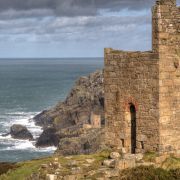Mineral Tramways Heritage project
The Mineral Tramways are a network of signposted, largely off-road trails that provide access and insight into what was once the largest tin and copper-producing area on the planet, also known as 'the richest square mile to be found in the old world.' The trails follow old tramways that were once used to transport raw material from the mines to the coast, where it could be exported.
The original project, which opened up some twenty miles of walks and tracks through the former mining areas of mid and west Cornwall, is thought to have helped bring attention to this fascinating historical landscape, which has since been made a UNESCO World Heritage Site. More trails, which are suitable for walking, cycling and horse riding, have recently been added, providing links with the original ones and bringing the total number of tramway miles up to nearly forty.
Some of the most popular mineral tramways include the Coast to Coast, now an official cycle route (national cycle network no. 3), an eleven mile trail that runs right across the county from the north to the south coast following horse drawn tramways that once served the tin and copper mines east of Redruth. The first section of this trail, which consists of the old Portreath to Scorrier tram-road, was the first surfaced tramroad in Cornwall, and dates back to 1812. The second section follows the old Redruth and Chacewater railway, which was built in 1825 to serve the mines in the Redruth area and to take copper ore from Gwennap (once known as the 'Copper Kingdom' after its riches) to Devoran, a village that owes it's very existence to the mining industry and the many wharves built by the railway company.
Another very popular trail is the Great Flat Lode, a seven mile circular walk/ride/cycle just south of Redruth and Camborne. Circling Carn Brea hill, once the busiest tin and copper mining area in the world, the trail consists of well-laid paths between the attractive granite sets of former mineral tramways. The Great Flat Lode was discovered in the 1870s, just as many other mines were closing, beneath previously-worked copper deposits south of Carn Brea. This magnificent (and much flatter than usual) lode was to produce nine thousand tonnes of high-quality tin concentrate!
The Great Flat Lode trail follows a line that was once part of the Basset Mine Tramway, which was built to carry tin ore for processing at Wheal Basset Stamps. There is a museum along the trail at King Edward Mine, open during the summer months.
Less well-known trails include Tehidy, Tolgus and Tresavean. Information about the trails is available from the Cornwall County Council website, while leaflets can be collected from Cornish Mines and Engines, in Camborne. Refreshments are available along the way in various pubs and cafes.








